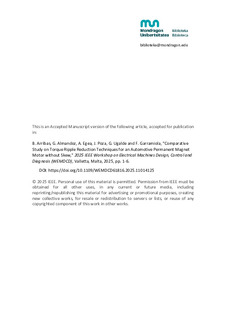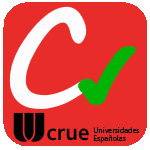
Izenburua
Comparative Study on Torque Ripple Reduction Techniques for an Automotive Permanent Magnet Motor without SkewEgilea
Argitalpen data
2025Bertsioa
PostprintaDokumentu-mota
Kongresu-ekarpenaHizkuntza
engEskubideak
© 2025 IEEESarbidea
Sarbide irekiaArgitaratzailearen bertsioa
https://doi.org/10.1109/WEMDCD61816.2025.11014125Non argitaratua
IEEE Workshop on Electrical Machines Design, Control and Diagnosis (WEMDCD) Valletta (Malta), 9-10 april 2025Argitaratzailea
IEEEGako-hitzak
Permanent magnet motor
Automotive
Torque ripple
ODS 7 Energía asequible y no contaminante ... [+]
Automotive
Torque ripple
ODS 7 Energía asequible y no contaminante ... [+]
Permanent magnet motor
Automotive
Torque ripple
ODS 7 Energía asequible y no contaminante
ODS 9 Industria, innovación e infraestructura
ODS 11 Ciudades y comunidades sostenibles
ODS 13 Acción por el clima [-]
Automotive
Torque ripple
ODS 7 Energía asequible y no contaminante
ODS 9 Industria, innovación e infraestructura
ODS 11 Ciudades y comunidades sostenibles
ODS 13 Acción por el clima [-]
Gaia (UNESCO Tesauroa)
ElektromagnetismoaLaburpena
Permanent magnet motors are a good choice for Electric Vehicles (EV) due to their high power density and efficiency. Additionally, reducing torque ripple is important to ensure comfortable and silent ... [+]
Permanent magnet motors are a good choice for Electric Vehicles (EV) due to their high power density and efficiency. Additionally, reducing torque ripple is important to ensure comfortable and silent vehicles. To achieve this, the step-skewing of the rotor is the most commonly adopted choice. However, stepskewing complicates the rotor manufacturing process, increasing its time and costs. Therefore, in this article, different alternatives to step-skewing are analysed for an EV motor, which are pole span optimisation, sinusoidal airgap, pole shifting, and magnetic slot wedges. The different methods are compared, and the results indicate that no single torque ripple reduction technique can reduce torque ripple below 10 % in all the working points. Thus, the proposed alternatives are combined, and the combination of pole shifting together with span optimisation is identified as the optimal solution. The results show that torque ripple is reduced to below 10 % in all the working points, while the average torque meets the application requirements. [-]
Finantzatzailea
Comisión EuropeaGobierno Vasco
Programa
Horizon-RIANon-Doctoral Research Staff Training Programme
Zenbakia
101096306PRE-2022-1-0137 and PRE-2023-2-0287
Laguntzaren URIa
https://doi.org/10.3030/101096306Sin información
Proiektua
Novel concept of a Low Cost, High Power Density and Highly Efficient Recyclable motor for next generation mass produced electric vehicles (HEFT)Sin información




















